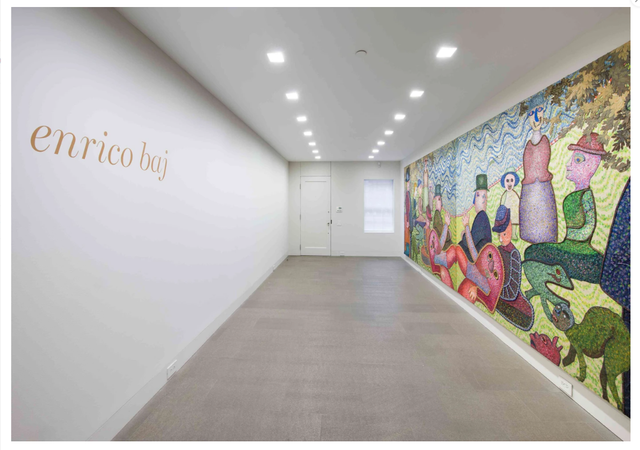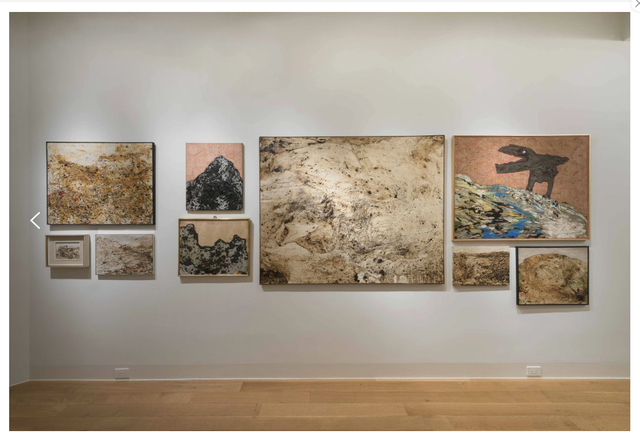Enrico Baj
Enrico Baj is a well-known Italian artist, prolific essayist, and polemicist. With a deep affinity for Surrealist and Dada movements, Baj constantly experimented with innovative techniques and stylistic approaches, creating collages and mixed-media assemblages using various materials, including textiles, metals, mirrors, and colored glass.
Biography of Enrico Baj
Enrico Baj was born in Milan, Italy, on October 31, 1924. He studied at the Accademia di Brera. In 1951, he, along with Sergio Dangelo and Gianni Dova, promoted the Movimento Arte Nucleare, a group of artists critical of nuclear power following the Hiroshima and Nagasaki bombings. The same year, he held his first solo exhibition in Milan at the Galleria San Fedele.
In 1953, he met Asger Jorn, and together, they founded the International Movement for an Imaginist Bauhaus, opposing the forced rationalization and geometry of art. This theme continued throughout Baj's career, and in 1957, he penned the manifesto "Contro lo stile" (Against Style), opposing formalism and its serial nature. In 1954, he organized the International Ceramics Meetings at Albisola in Liguria, Italy.
In 1960, Baj made his debut in New York as part of the "Surrealist Intrusion in the Enchanters’ Domain" exhibition, organized by Marcel Duchamp and André Breton at the D’Arcy Galleries. The following year, his works were featured in the significant exhibition "Art of Assemblage" (1961) at the MoMA in New York, curated by William Seitz. In France, André Breton invited him to exhibit with the Surrealists, and in 1963, an essay dedicated to Baj was published in Rosamond and George Bernier’s magazine 'L’oeil.' In 1964, Baj was honored with a dedicated room at the Venice Biennale, with a presentation by Raymond Queneau.
Starting in 1967, the artist began exhibiting his works at Studio Marconi, and in the 1970s, he held his first significant retrospectives, including exhibitions at Palazzo Reale in Milan, Museum Boijmans van Beuningen in Rotterdam, and Palais des Beaux-Arts in Brussels. In 1971, he participated in three major exhibitions, namely at Palazzo Grassi in Venice, the Museum of Contemporary Art in Chicago, and the Musée de l’Athénée in Geneva.
Baj was a tireless writer, having published numerous books, including "Automitografia" (Rizzoli, 1983) and works on art history, like "Che cos’è la Patafisica" (Lanfranchi, 1994).
The artist passed away in Vergiate, near Varese, Italy, in 2003.
Today, his artworks can be found in collections worldwide, including MoMA in New York, the Museum of Fine Arts Houston (MFAH), the British Museum, Tate Modern in the UK, the Irish Museum of Modern Art (IMMA) in Dublin, and the Stedelijk Museum voor Actuele Kunst (S.M.A.K.) in Ghent. In Italy, his works are housed in various institutions, including the Galleria Nazionale d’Arte Moderna in Rome, MUSEION in Bolzano, Peggy Guggenheim Collection in Venice, Galleria d’Arte Moderna e Contemporanea di Bergamo (GAMeC), and Museo del Novecento in Milan.
Enrico Baj's Art Style
Enrico Baj's artistic experiments resulted in multicolored collages made from various materials. His work emphasizes the joyful experience of painting with diverse materials while providing social commentary and strong criticism of contemporary society. This is evident in his "Generali and Parate military" series from the 1960s, and even more so in works from the 1970s, like "I funerali dell'anarchico Pinelli" (1972) and "Apocalisse" (1979).
In the 1980s, he briefly abandoned collage and created a series of works called "Metamorfosi e Metafore" (1988), based on imagination and fantasy. In 1993, he began his "Maschere tribali" cycle, using waste materials of modern civilization to create ironic and brightly colored masks. These pieces were followed by the "Feltri" (1993-98) and "Totem" (1997) series.
Years:
Born in 1924
Country:
Italy, Milan
Gallery:
Luxembourg + Co.
Galerie Georges-Philippe & Nathalie Vallois
Tornabuoni Art




